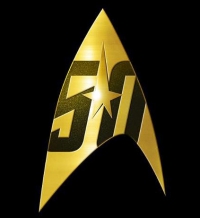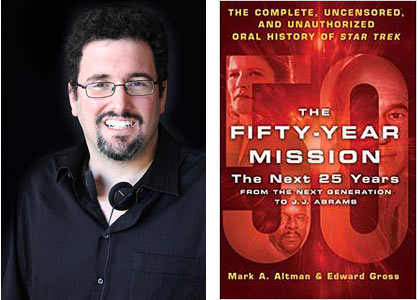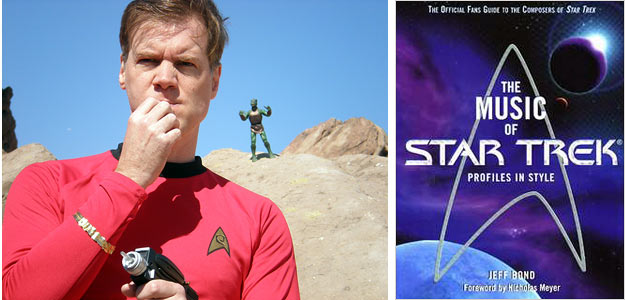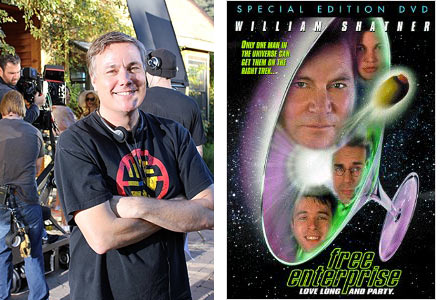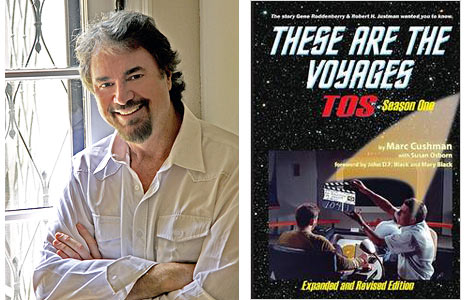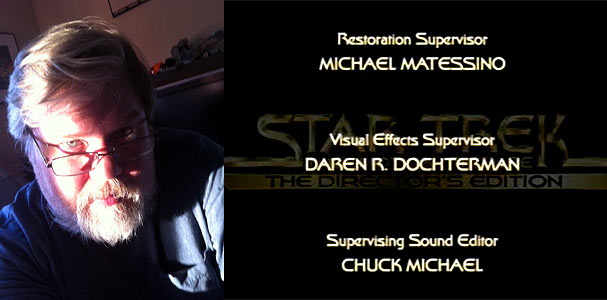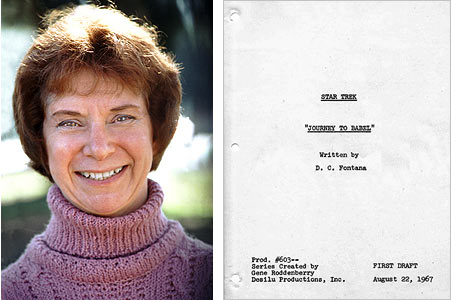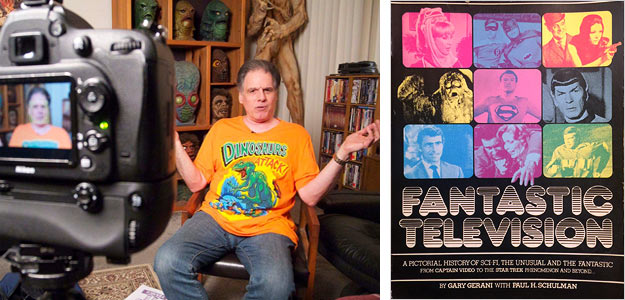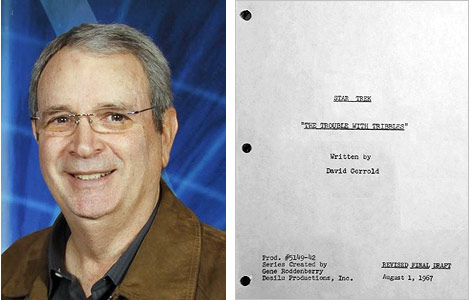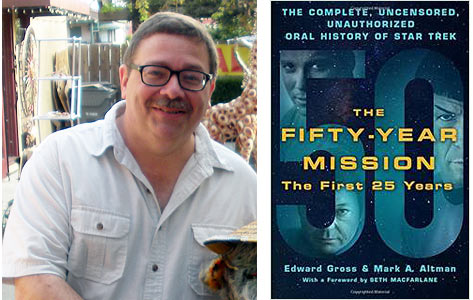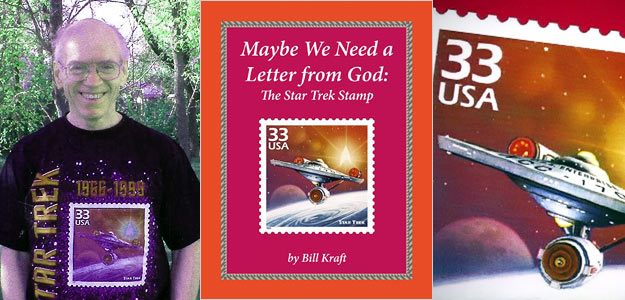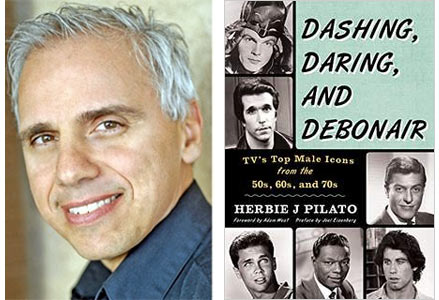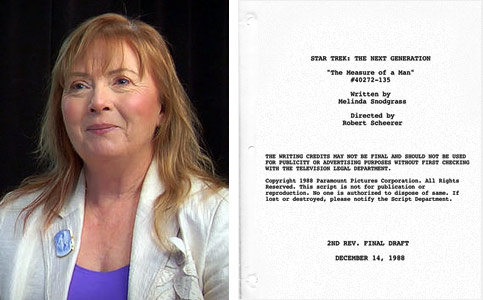“Star Trek has left a legacy of hope and optimism that humankind has a future. If we cultivate the potential of Infinite Diversity in Infinite Combinations so that we embrace a universe brimming with the riches of life in all of its forms, then humankind can evolve into something finer and nobler. I think that is what Gene Roddenberry meant when he said that the human adventure is just beginning.” — Bill Kraft, author of Maybe We Need a Letter from God: The Star Trek Stamp
The Digital Bits and History, Legacy & Showmanship are pleased to present this retrospective article commemorating the golden anniversary of Star Trek, Gene Roddenberry’s legendary science-fiction television series depicting the voyages of Captain James T. Kirk and his crew of the starship Enterprise.
The memorable television series premiered 50 years ago this week (September 6th, 1966, on CTV in Canada, and September 8th, 1966, on NBC in the United States), and similar to our other Star Trek roundtables (here and here) and classic television retrospectives (here, here, here, and here), The Bits for the occasion has assembled a Q&A with an esteemed group of Treksperts, historians and Star Trek writers who examine the best episodes and offer commentary on the show’s enduring appeal, influence and legacy. [Read on here...]
Okay, it’s a big article, so let’s get right to it and introduce the participants. In alphabetical order…
Mark A. Altman has been called “the world’s foremost Trekspert.” He is co-author (with Edward Gross) of the bestselling The Fifty-Year Mission: The Complete, Uncensored, Unauthorized Oral History of Star Trek, recently published by St. Martin’s Press (currently available in hardcover, Kindle and audiobook). In addition to being the writer/producer of the award-winning romantic comedy Free Enterprise, starring William Shatner and Eric McCormack (see our roundtable on the film here), he is currently co-executive producer of The Librarians for TNT and has been a writer/producer on such series as Agent X, Necessary Roughness, Castle and Femme Fatales, which he co-created for Cinemax.
Jeff Bond is the author of The Music of Star Trek (Lone Eagle, 1999). He also wrote Danse Macabre: 25 Years of Danny Elfman and Tim Burton (included in The Danny Elfman & Tim Burton 25th Anniversary Music Box, Warner Bros., 2011) and is co-author with Joe Fordham of Planet of the Apes: The Evolution of the Legendary Franchise (Titan, 2014). Jeff is the former editor of Geek magazine, covered film music for The Hollywood Reporter for ten years, and has contributed liner notes to numerous CD soundtrack releases. He also has portrayed Dr. McCoy on the Star Trek New Voyages: Phase II Internet series.
Robert Meyer Burnett directed, co-wrote and edited Free Enterprise (see our roundtable on the here) and co-produced and edited the supplemental material for the Blu-ray season sets of Star Trek: The Next Generation and Star Trek: Enterprise. He has worked as a Star Trek consultant for Viacom Licensing and edited all of the video packages at the late Star Trek Experience in the Las Vegas Hilton. He developed and produced The Hills Run Red and co-produced Agent Cody Banks and its sequel, as well as directed and edited several episodes of the Cinemax series Femme Fatales. He is the owner of Ludovico Technique, which specializes in the production of Value Added Material for DVD and Blu-ray releases. He has produced VAM for titles such as The Usual Suspects, Superman Returns, X-Men, and The Chronicles of Narnia: The Lion, The Witch and the Wardrobe. He also recently edited the award-winning Star Trek fan film Prelude to Axanar and was slated to direct the feature film Axanar before the project was hit with a copyright lawsuit from franchise rights holders Paramount and CBS and shut down.
[Editor’s Note: In the interest of full disclosure, Digital Bits editor Bill Hunt was also the screenwriter for the Axanar feature film project.]
Marc Cushman is a Los Angeles-based screenwriter and director, who also writes books documenting the making of classic TV series, including the Saturn Award winning three-book set These Are the Voyages, (Jacobs Brown Press, 2013-2015; www.thesearethevoyagesbooks.com), with one volume for each of Star Trek’s three broadcast seasons. Other books include I Spy: A History and Episode Guide to the Groundbreaking Television Series (McFarland, 2007) and Irwin Allen’sLost in Space: The Authorized Biography of a Classic Sci-Fi Series, (Jacobs Brown Press, 2016), tracing the development and production of the show that paved the way for Star Trek, as well as the early career of creator/producer Irwin Allen.
Daren R. Dochterman has worked in the motion picture industry for over thirty years as a concept designer and production illustrator, storyboard artist, visual effects artist, and art director. He’s been a director, editor, sound man, model builder, compositor, and actor. He also is an instructor at Art Center College of Design in Pasadena, California, and creative director of the Star Trek Original Series Set Tour. He was also Visual Effects Supervisor on Star Trek: The Motion Picture—The Director’s Edition and is arguably the only person in the world to do a Gene Roddenberry impression.
Dorothy Fontana was the Story Editor for the first two seasons of Star Trek and writer (or co-writer) of several episodes including Charlie X, Tomorrow Is Yesterday, This Side of Paradise, Journey to Babel, Friday’s Child, and The Enterprise Incident. Subsequent Trek series scripts included Yesteryear (The Animated Series), Encounter at Farpoint (The Next Generation), Dax (Deep Space Nine) and To Serve All My Days (Star Trek: New Voyages). As well, she has written for numerous other TV series, including Babylon 5, Bonanza, Dallas, Land of the Lost, Logan’s Run, The Six Million Dollar Man, The Streets of San Francisco, and The Waltons.
Gary Gerani is the author (with Paul H. Schulman) of Fantastic Television: A Pictorial History of Sci-Fi, The Unusual, and the Fantastic from Captain Video to the Star Trek Phenomenon and Beyond (Harmony, 1977). Gary is known as the Card King, having written and edited more trading cards than anyone else, including the Topps Star Wars sets, which Abrams Books has recently reprinted in book form. He co-wrote the screenplay for Stan Winston’s Pumpkinhead and is currently directing a documentary about the film/TV composer Billy Goldenberg (Spielberg’s Duel, among others). He also owns his own publishing company, Fantastic Press, in a partnership with IDW.
David Gerrold is the writer of several episodes of the various Star Trek shows, including The Original Series (The Trouble with Tribbles), The Animated Series (More Tribbles, More Troubles and Bem) and The Next Generation (Blood and Fire, which was rejected by TNG producers but eventually produced as an episode of Star Trek: New Voyages). His Star Trek-themed non-fiction includes The Trouble with Tribbles: The Birth, Sale, and Final Production of One Episode (Ballantine, 1973) and The World of Star Trek (Ballantine, 1973; revised in 2016), and Trek-themed fiction include The Galactic Whirlpool (Bantam, 1980) and Encounter at Farpoint (Pocket, 1987). Non-Trek-themed novelettes and books penned by Gerrold include The Martian Child (1994), and the Star Wolf (Spectra, 1972-2004) and The War Against the Chtorr series (Spectra, 1983-1993). He has also written for Babylon 5, Land of the Lost, Sliders and The Twilight Zone (1985).
Edward Gross is a veteran entertainment journalist who has been on the editorial staff of a wide variety of magazines, among them Geek, Movie Magic, Cinescape, Starlog, SFX, Life Story, CFQ and Sci Fi Now. He has authored or co-authored such nonfiction books as Planet of the Apes Revisited, Rocky: The Complete Guide, Above & Below: A 25th Anniversary Beauty and the Beast Companion and summer 2016’s two-volume The Fifty-Year Mission: The Complete, Uncensored, Unauthorized Oral History of Star Trek. Currently he serves as executive editor on Empire magazine’s empireonline.com/us.
Bill Kraft spearheaded the successful 13-year campaign (1985-1998) to honor Star Trek on a U.S. postage stamp. He grew up on the remote plains of Strasburg, North Dakota, and cultivated his passion for movies at the town’s only theater until television arrived in 1953. He got his B.A. in English from St. John’s University, Collegeville, MN, and taught high school English at Pipestone, MN, and at St. Cloud Cathedral High School, St. Cloud, MN. He has a passion for the writings of Thomas Wolfe and Washington Irving and fulfilled life-long ambitions with pilgrimages to Wolfe’s gravesite, Thomas Wolfe Memorial in Asheville, NC, and Irving’s residence of Sunnyside on the banks of the Hudson River in New York. Bill’s favorite movie is Lawrence of Arabia, but the last 15 minutes of Star Trek: The Motion Picture became the impetus behind his “conversion” to Star Trek and the motivation behind the Star Trek stamp campaign and his book Maybe We Need a Letter from God: The Star Trek Stamp (2013). Bill and his wife Karla live in Sauk Rapids, MN.
Herbie J Pilato is a classic television historian and the author of Dashing, Daring, and Debonair: TV’s Top Male Icons from the 50s, 60s, and 70s (Taylor Trade Publishing, 2016), which includes profiles of William Shatner, Leonard Nimoy, DeForest Kelley and Gene Roddenberry. The writer, producer, lecturer and consultant has penned numerous other books, including Glamour, Gidgets, and the Girl Next Door: Television’s Iconic Women from the 50s, 60s, and 70s (Taylor Trade Publishing, 2014), The Bionic Book: The Six Million Dollar Man & the Bionic Woman Reconstructed (Bear Manor Media, 2007), The Bewitched Book (Delta, 1992), Bewitched Forever: The Immortal Companion to Television’s Most Magical Supernatural Situation Comedy (Tapestry, 1996; and updated in 2004), Twitch Upon a Star: The Bewitched Life and Career of Elizabeth Montgomery (Taylor Trade Publishing, 2012), The Essential Elizabeth Montgomery: A Guide to her Magical Performances (Taylor Trade Publishing, 2013), and NBC & Me: My Life as a Page in a Book (Bear Manor Media, 2008). He heads the production company Television, Ink., was a consulting producer on the DVD season sets of Bewitched, CHiPs, Kung Fu and The Six Million Dollar Man, and established The Classic TV Preservation Society.
Melinda Snodgrass was the Story Editor for the second season of Star Trek: The Next Generation and writer (or co-writer) of several episodes including The Measure of a Man, Pen Pals and The High Ground, as well as the Trek novel The Tears of the Singers (Pocket, 1984). She is a recovered lawyer, a screenwriter and novelist with works available from Tor Books — The Edge of Reason, The Edge of Ruin and The Edge of Dawn, and Titan Books — The Imperials series (The High Ground and the soon to be released Evil Times). She’s working on the third book in that series. She also co-edits and writes for the Wild Cards book series with George R.R. Martin, and is the executive producer on the upcoming Wild Cards TV series. As well, she has written for numerous other TV series, including L.A. Law, The Outer Limits (1995-2002), Profiler, and Sliders. She is an FEI dressage rider who owns two Lusitano horses — her stallion Vento da Broga, and her new young horse Donhador.
The interviews were conducted separately and have been edited into a “roundtable” conversation format.
Michael Coate (The Digital Bits): In what way is Star Trek worthy of celebration on its 50th anniversary?
Mark A. Altman: Star Trek is a remarkable cultural touchstone. It’s more than just a TV series, but one of the most significant landmarks of 60s popular culture. Along with the Beatles, James Bond and Woodstock, it is the 60s. Star Trek wasn’t just a science fiction series, it had something meaningful to say about the human condition; who we were and are as a race. It also was remarkably prescient in terms of anticipating technological developments, if not over the next 300 years, certainly the next 30 years. It is hard now to realize the immense achievement of the series given the constraints of the time in advancing the nature of visual effects, futurism and humanism and is being justifiably lauded for its remarkable achievement.
Jeff Bond: It’s stunning and gratifying to me that Star Trek is still viable and a huge part of our culture 50 years after it was first broadcast and almost 50 years after it essentially failed and was cancelled. It’s certainly one of the most amazing success stories in entertainment.
Robert Meyer Burnett: Aside from an errant voyage by James Cameron to the bottom of the Marianas Trench, humanity no longer has any more real frontiers to conquer. Sure, technology marches on, and assuming we survive the 21st Century, biotech, AI and god knows what other Lawnmower Man comes screaming down the pike, will keep changing human life, hopefully for the better, but we currently don’t have many places to go, nor the technology to get there…. But Star Trek constantly reminds us one day, we will indeed boldly go where no one has gone before, and ultimately, it will be a good thing, a very good thing, we’ve done so. From the first men cowering in caves from the moonlight, who awakened the next morning to push forward over the next hill, an element of humanity must constantly be moving, exploring and pushing the boundaries of our experience of the world, indeed the universe, around us. To be the first person to stand on a mountaintop, feel the wind through your hair and see the unique sunrise from that vantage point, informs our very soul…. Star Trek reminds us we must continue to strive for the stars, continue to push the boundaries of knowledge and imagination, even in the face of the constant turmoil of our day to day existence here on this planet. Perhaps now more than ever, mankind needs to be reminded although we are a mere speck of cosmic dust, we have the ability to reach for the very secrets of the universe itself.
Marc Cushman: If ever a series was worthy of having a big bash of a 50th anniversary celebration, this is the one…. Following I Spy, from one season earlier, Star Trek helped to establish multi-racial casting on television in non-stereotypical roles. In fact, this was the first multi-racial series on primetime TV in the U.S. And the first to send a black woman into outer space! It brought us TV’s first interracial kiss — between white and black, white and green, human and Vulcan, you name it! And that is major…. Gene Roddenberry was into taking chances because he was a writer with much to say. Back in the mid-1960s, entertainment shows in primetime were not supposed to touch on hot topic issues, and few dared to risk upsetting the networks. But Roddenberry and Star Trek did, every week. We saw stories about racism, sexism, religion, overpopulation, Vietnam, the U.S.S. Pueblo, and on and on. And America got its first look at the mini-skirt! With these type of stories, and its sexiness, Star Trek was considered by many TV critics to be America’s first “adult science fiction series.”…. Star Trek was the first to win a Hugo award as “Best Science Fiction Presentation of the Year” (in 1967 for The Menagerie, a year when three of the five nominated “films” were Star Trek episodes), and again, in 1968 (The City on the Edge of Forever, a year when all five nominations were for episodes from Star Trek!). It was the first sci-fi series to be nominated for a primetime Emmy award as “Best Dramatic Series” (two years in a row, in 1967 and 1968). And Leonard Nimoy was the first actor in a science fiction series to be nominated for a primetime Emmy (as Best Supporting Actor in a Dramatic Role), three years in a row, no less, in 1967, ’68 and ’69! These accomplishments are historic, and opened people’s minds and the doors of the entertainment industry for acknowledging science fiction in the future…. It was the first series to film a miniature (if you can call that eleven foot, two inch Enterprise they used a miniature) in front of a blue screen. And the first to use several animation plates to create moving stars, as a composite shot to combine with that of the Enterprise. This was state of the art for its time. It invented the art! And let’s not forget the innovations in science that came about as a result of Star Trek — a mere TV series. Many inventors from the last thirty years have admitted that they got their ideas from watching Star Trek when they were children. Did your first cell phone look like Kirk’s flip-open communicator? Of course, and for good reason. Censor activated automatic doors, Bluetooth, CDs, DVDs the PC, the Internet, the MRI, Kindle, and on and on — you can see all of these things decades before they were invented in Star Trek episodes. And you can be sure the inventors saw them too.
Daren R. Dochterman: Star Trek existed in a strange nexus of time and history. It happened as societal pressures were boiling over, and technical advancements were heading to one of the most important events in human history, the moon landing. It was a barometer of these happenings, it was a release valve, it was a sign post leading to a world where all these factors had advanced and represented a future where mankind would not only survive, but flourish. Its integrated cast didn’t call attention to itself, by saying, “Hey, look at how progressive we are being”… it just was. It inspired to show where we might be going, while masquerading as a simple adventure show. It is almost unheard of for something from popular culture maintaining its presence 50 years later… and I think that it is interesting how many things from that specific time period are still remembered fondly with vociferous fan bases, but none of those other pop culture offerings have gone through so many reworkings and variations and still held on to its innate qualities. With all the permutations and up-rezzing that has gone on to the “franchise,” the original 79 still remain an interesting and engaging look into both our past, and our future.
Dorothy Fontana: How many other fifty-year-old shows are still being syndicated — and adored by fans — the same way Star Trek is? It’s still a kick for me to meet younger people who tell me they watched the show with their parents and are still watching it in syndicated reruns. And they’re buying the reissued shows on DVD and Blu-ray, to watch them all over again in these new formats. The stories and the characters still hold up — and still engage and entertain audiences.
Gary Gerani: It was the first science fiction series with fully-defined characters that you cared about, and the fantastical notions never insulted your intelligence — they were based on real scientific principles or theories. It also helped viewers to appreciate racial diversity, using science fiction to show us the way to a smarter, more progressive and hopeful future.
David Gerrold: No other television show has had the cultural impact of Star Trek. It has become an iconic American mythology. Star Trek predicted tablets and talking computers and personal communicators, sliding doors and silvery discs for storing data — and now we have all those things. And more. But more than that, Star Trek continues to inspire the audience with an optimistic vision of the future, a future in which everybody is valued for what they can contribute.
Edward Gross: In the same way that James Bond was back in 2012 or the 50th anniversary of The Beatles’ “invasion” of America was in 2014: to have an element of pop culture not only be celebrated, but to still be thriving half a century after its inception is remarkable. Especially today when things have become so disposable. New feature film, new television series, and a franchise that remains so revered is absolutely worthy of celebration.
Bill Kraft: Star Trek broke ground for science fiction on television. Before then, TV science fiction was strictly Saturday morning “kid-stuff,” which no one took seriously. It didn’t deal with ideas or comment on the human condition as Star Trek does. Star Trek’s longevity and sheer output of over 700 hours of storytelling attest to its durability. I think the first 50 years are but a harbinger of another 50 years or more. It’s time to acknowledge and celebrate the achievement of one of the most durable franchises in the annals of entertainment and pop culture.
Herbie J Pilato: First and foremost, the scripts, visuals, and characters were vibrant with imagination, wonder, hope, discovery, excitement, and adventure… all the colors of the Universe, however they are defined within the specific confines of optimum storytelling. The casting of each character, be they a regular or a guest character, was on-the-money. The importance of casting far too-many times is ignored when producing any kind of production for television, film or stage, for that matter. And on Star Trek — the original series, the casting was pristine.
Melinda Snodgrass: Star Trek presented the possibility of a united Earth and people who no longer saw national borders or skin color. That was a major achievement during the 1960s while fear of Communism raged and African-Americans were struggling for equal protection and acceptance in their own country.


